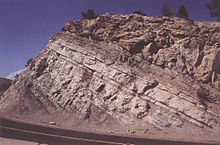Dakota Formation
| Dakota Formation Stratigraphic range: Upper Cretaceous |
|
|---|---|

Outcrop of Dakota Formation at crest of Dinosaur Ridge, near Golden, Colorado
|
|
| Type | Geologic formation |
| Overlies | Morrison Formation (Rocky Mountains) |
| Lithology | |
| Primary | sandstone |
| Other | shale |
| Location | |
| Region | Rocky Mountains, Great Plains |
| Country | United States, Canada |
| Type section | |
| Named for | Dakota City, Nebraska |
| Named by | Meek and Hayden, 1862 |
The Dakota Formation (also Dakota Sandstone and Cockrum Sandstone, more formally the Dakota Group) is a geologic formation composed of sedimentary rocks deposited on the eastern side of the Late Cretaceous Western Interior Seaway. F.B. Meek and F.V. Hayden named it for exposures along the Missouri River near Dakota City, Nebraska.
The strata lie unconformably atop Paleozoic and Precambrian rocks, and are the oldest Cretaceous rocks in the northern Great Plains, including Kansas, Nebraska, Iowa, Minnesota, and Wisconsin. It consists of sandy, shallow-marine deposits with intermittent mud flat sediments, and occasional stream deposits.
The Dakota Formation is an important aquifer in some areas of the Great Plains.
Deposition of the sediments that would become the Dakota Formation began during the early Late Cretaceous (Cenomanian). This deposition marked a reversal from millions of years of erosion. This reversal was due to rising of the mouth of the rivers, called a rise in base level, as the Cretaceous Seaway formed. This rise lowers the gradient of the rivers causing them to deposit sediment because their velocity can no longer sustain high volumes of sediment.
Measurements show that the rivers flowed westward and southwestward towards the encroaching sea from source areas near the present-day Great Lakes. The point of deposition slowly moved eastward as the seaway rose. This change is seen by a gradual shift in the composition of sandstones from having a lot of Paleozoic-age rock detritus in Kansas to sandstones having all Precambrian crystalline rock debris in Iowa.
...
Wikipedia
